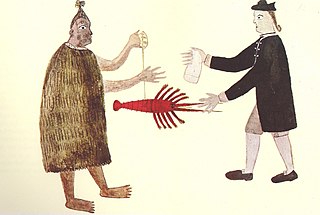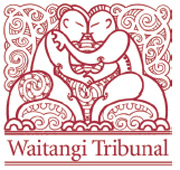History
Pre-European law
Before colonisation by the British, Māori customary law (tikanga) would have served as rule of law for most tribes.
The first mention of New Zealand in British statutes is in the Murders Abroad Act of 1817, [1] which clarified that New Zealand was not a British colony (despite being claimed by Captain Cook) and "not within His Majesty's dominions". [2]
Treaty of Waitangi
The Treaty of Waitangi was signed in 1840. Although the Treaty had never been incorporated into New Zealand municipal law, [3] its provisions were first incorporated into legislation as early as the Land Claims Ordinance 1841 and the Native Rights Act 1865. [4] However, in the 1877 Wi Parata v Bishop of Wellington judgement, Judge Prendergast argued that the Treaty was a "simple nullity" in terms of transferring sovereignty from Māori to the United Kingdom. [5] This remained the legal orthodoxy until at least the 1970s. [6] Māori have since argued that Prendergast's decision, as well as laws later based on it were a politically convenient and deliberate ploy to legitimise the seizure of Māori land and other resources. [7]
In 1975, the Treaty of Waitangi Act became law. It established the Waitangi Tribunal. The tribunal had authority to investigate post-1975 Māori grievances; to make findings of fact; and to make non-binding recommendations. The act was amended in 1985 to enable the tribunal to consider grievances back to 1840 and to increase the tribunal's membership. [8] [9]
The Treaty was incorporated in a limited way into New Zealand law by the State Owned Enterprises Act 1986. Section 9 of the act said "Nothing in this Act shall permit the Crown to act in a manner that is inconsistent with the principles of the Treaty of Waitangi". [10] The government had proposed a transfer of assets from former Government departments to state-owned enterprises, but because the state-owned enterprises were essentially private firms owned by the government, there was an argument that they would prevent assets which had been given by Māori for use by the state from being returned to Māori by the Waitangi Tribunal and through Treaty settlements. [11] The Act was challenged in court in 1987, and the judgement of New Zealand Maori Council v Attorney-General defined the "Principles of the Treaty" and the proposed sale of government assets was found to be in breach of this proviso. This allowed the courts to consider the Crown's actions in terms of compliance with the Treaty and established the principle that if the Treaty is mentioned in strong terms in a piece of legislation, it takes precedence over other parts of that legislation should they come into conflict. [10] The "Principles of the Treaty" became a common topic in contemporary New Zealand politics, [12] and in 1989, the Fourth Labour Government responded by adopting the "Principles for Crown Action on the Treaty of Waitangi" a similar list of principles to that established in the 1987 court case. [13]
Court system

A Supreme Court was first established in 1841 (it was renamed the High Court in 1980, and is different from the current Supreme Court), and various lower courts subsequently established. Its establishment followed the arrival in New Zealand of the first chief justice, William Martin, and it heard its first case in January 1842. [14] The magistrates' courts came into being in 1846 [15] (replaced by district courts in 1980). The Court of Appeal was set up in 1862 and originally consisted of panels of judges from the Supreme Court. [16] The Court of Appeal was the highest court in New Zealand, although appeals could be taken from this to the Judicial Committee of the Privy Council in London. In 1957 the Court of Appeal was reconstituted to become separate from the Supreme Court, having its own judges. [16] In 2004 a new Supreme Court was established, becoming New Zealand's court of last resort following the simultaneous abolition of the right to appeal to the Privy Council. [17]
In 1865 a Native Land Court was established to "define the land rights of Māori people under Māori custom and to translate those rights or customary titles into land titles recognisable under European law". [18] It has since been heavily criticised for acting as a device for removing Māori from their land. Some of the problems were with the court itself – holding proceedings in English and in cities far from Māori settlements, judges with inadequate knowledge of Māori custom – while others were more to do with the laws it enforced. For example, for many decades land law did not recognise that an entire hapu owned its land, and land ownership was put in the hands of a few people. In 1954 it was renamed the Māori Land Court, and has been substantially reformed since the nineteenth century. Until the mid-twentieth century it also dealt with Māori adoptions.
The New Zealand judiciary have generally been seen as independent and non-corrupt, although not always non-biased. Until recent years they have played a very minor role in developing the law, and as late as 1966 it was said that they "usually follow English decisions scrupulously". [19] In the 1980s the judiciary played a major role in redefining the constitutional position of the Treaty of Waitangi.
New Zealand Bill of Rights Act
The New Zealand Bill of Rights Act was enacted in 1990 to affirm fundamental rights and freedoms set out in the International Covenant on Civil and Political Rights. [20] While the Bill of Rights Act is not a superior law to which all other laws are subject, judges are required to interpret other statutes to be consistent with it if at all possible. If there is an inconsistency, the attorney-general must inform Parliament. [21]








